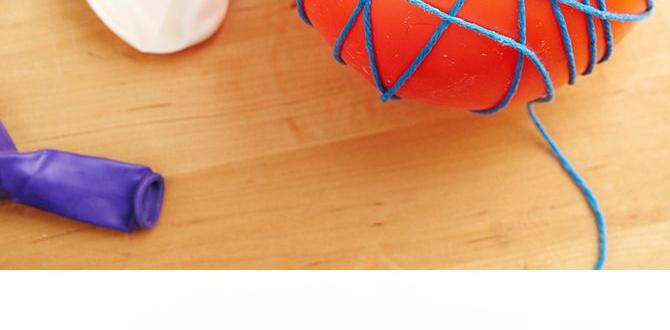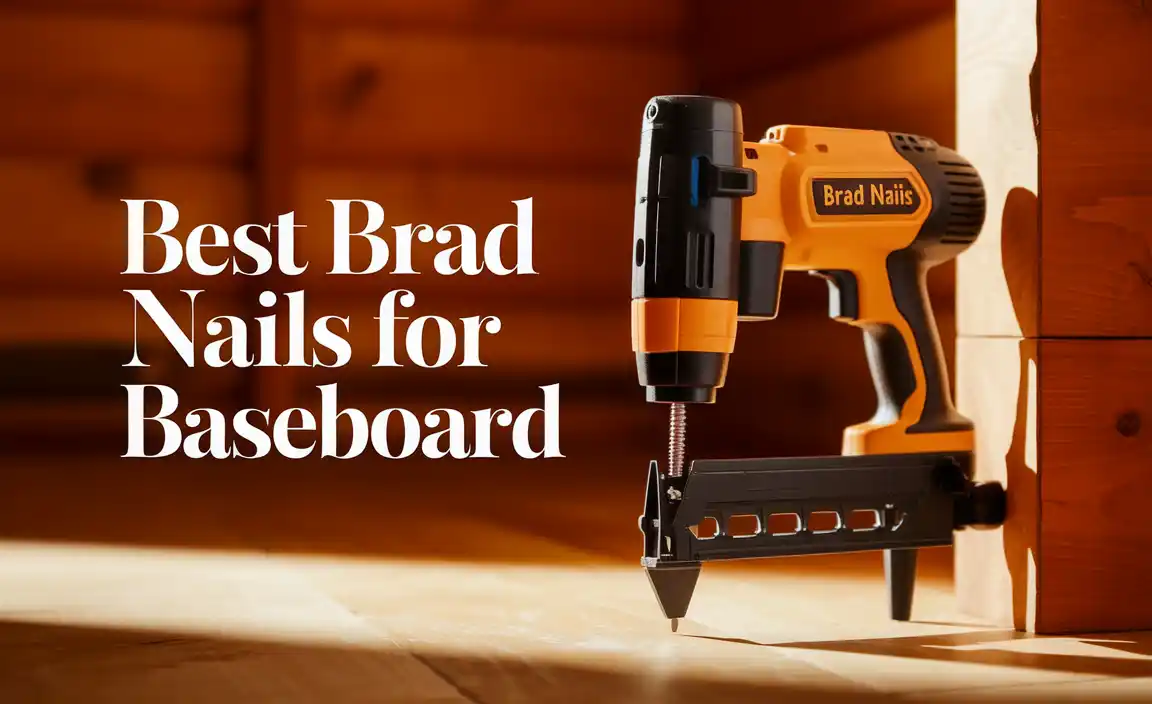Quick Summary:
To repair a nailer air cylinder, you’ll need to safely disassemble the tool, identify the worn or damaged O-rings or seals, clean replaced parts, and reassemble carefully. This guide provides step-by-step instructions for a successful repair, saving you money and getting your nailer back to work.
Hey there, DIYers and woodworking fans! It’s Jack Shaffer from Nailerguy, and I’ve got your back today. Ever been in the middle of framing a wall or finishing a beautiful piece of furniture, only for your trusty nailer to start acting up? A common culprit behind a weak or leaking nailer is a problem with the air cylinder. Don’t worry, it’s not the end of the world, and you don’t necessarily need a new tool! This guide will walk you through how to repair a nailer air cylinder step-by-step. We’ll make it easy and stress-free, so you can get back to building. Let’s dive in!
Table of Contents
Why Your Nailer’s Air Cylinder Might Need a Fix
The air cylinder is the heart of your pneumatic nailer. It’s where the magic happens – where compressed air is stored and then released with force to drive nails. When this cylinder has issues, your nailer won’t perform as it should. You might notice a few tell-tale signs that your air cylinder is a problem:
- Weak or Inconsistent Nailing: Nails aren’t driven all the way in, or the power varies from shot to shot.
- Air Leaks: You can hear hissing sounds when the tool is pressurized, even when not firing.
- Slow Piston Return: The driver blade might not retract quickly, or it might get stuck.
- Leaking from the Handle: Air might be escaping around the handle area.
Often, these problems are caused by worn-out O-rings or seals within the cylinder. These small rubber components keep air from escaping and ensure smooth operation. Over time and with heavy use, they can degrade, tear, or become brittle. The good news is that replacing these seals is usually a straightforward repair that will breathe new life into your tool.
Gathering Your Tools and Parts
Before we begin, let’s make sure you have everything you need. Having all your supplies ready will make the repair process much smoother. Safety first, always!
Essential Tools:
- Safety Glasses: Non-negotiable for protecting your eyes.
- Work Gloves: To protect your hands from sharp edges and grease.
- Screwdriver Set: You’ll likely need Phillips and flathead screwdrivers.
- Allen Wrench Set (Hex Keys): Many nailers use hex bolts for disassembly.
- Pliers: Needle-nose pliers can be very handy for gripping small parts.
- Small Pick Tool or Awl: For carefully prying out old O-rings.
- Clean Lint-Free Cloths: For cleaning parts.
- Nailer-Specific Repair Kit: This is crucial! It will contain the exact O-rings and seals your model needs. You can usually find these on the manufacturer’s website or at reputable tool supply stores.
- Lubricating Oil: A small amount of tool oil specifically for pneumatic tools.
- Compressed Air Source: To test the tool after the repair (optional but recommended).
Finding the Right Repair Kit
This is arguably the most important step. Your nailer’s air cylinder is designed for specific seals. Using the wrong ones can lead to leaks or further damage. Here’s how to find the correct kit:
- Identify Your Nailer Model: Look for a sticker or engraved plate on your nailer that clearly states the brand and model number.
- Check Your Owner’s Manual: The manual often lists part numbers for internal components and recommended maintenance kits.
- Manufacturer’s Website: Most major tool brands have online parts diagrams and service information. Search for your model number.
- Reputable Tool Parts Suppliers: Websites that specialize in tool repair parts are excellent resources.
Pro Tip: If you’re unsure, give the manufacturer’s customer support a call. They can often guide you to the correct repair kit based on your tool’s model and serial number.
Step-by-Step Guide: How to Repair a Nailer Air Cylinder
Let’s get your nailer back in working order. Follow these steps carefully. Remember to work in a well-lit, clean, and organized area.
Step 1: Disconnect Air and Safety First!
This might seem obvious, but it’s critical. Always disconnect the air hose from your nailer before starting any maintenance or repair. Also, ensure there are no nails loaded in the magazine. Double-check to be completely sure.
Step 2: Disassemble the Nailer
Most nailer repairs involve disassembling the tool in a specific order. You typically need to remove the rear cap or handle assembly.
- Locate Fasteners: Look for screws or bolts around where the air hose connects to the handle, or at the very rear of the handle.
- Remove Fasteners: Use the appropriate screwdriver or Allen wrench to carefully remove these screws. Keep them in a safe place. Sometimes, these are captive screws, meaning they won’t come all the way out, which is helpful.
- Remove the Rear Cap/Handle: Gently twist and pull the rear cap or handle assembly away from the main body of the nailer. It might be a snug fit. If it’s stuck, a gentle tap or wiggling might help. Be careful not to force it.
Referencing your nailer’s manual is highly recommended here, as the disassembly sequence can vary significantly between brands and models. You can often find service manuals or exploded diagrams online on the manufacturer’s website.
Step 3: Access the Air Cylinder and Piston
Once the rear cap is off, you should see the internal mechanism, often including the piston and driver blade. The air cylinder is typically the main housing that the piston moves within.
- Identify Key Components: You’ll usually see the main piston assembly, which has the driver blade attached or integrated. The cylinder is the larger tube it slides in.
- Remove the Piston Assembly: Depending on the design, the piston assembly might slide out easily once the rear cap is removed. In other cases, it might be held in place by a retaining ring or a few screws within the cylinder itself. Again, your manual is your best friend here.
- Carefully Mark Orientation: As you remove parts, it’s a good idea to note or lightly mark their orientation. This helps immensely during reassembly.
Step 4: Inspect and Replace O-Rings and Seals
This is the core of the repair. Once you have the piston and cylinder accessible, look for the rubber O-rings and seals.
- Locate O-Rings: There are usually several O-rings. One common place is on the piston itself. There might also be seals at the rear of the cylinder where the piston enters, and potentially at the front near the nose of the nailer.
- Remove Old Seals: Use your pick tool or a small, non-marring pick to carefully pry out the old O-rings. Be gentle! You don’t want to scratch the metal surfaces of the cylinder or piston.
- Clean the Area: Before installing new parts, wipe down the inside of the cylinder and the piston with a clean, lint-free cloth to remove any old lubricant, debris, or metal shavings.
- Install New Seals: Take the new O-rings and seals from your repair kit. Lightly lubricate them with a small amount of pneumatic tool oil. This helps them seat properly and prevents tearing during installation. Carefully fit the new O-rings into their respective grooves. Ensure they are seated evenly and are not twisted.
Step 5: Reassemble the Nailer
Reassembly is the reverse of disassembly. Work carefully and methodically.
- Reinsert Piston Assembly: Carefully slide the piston assembly back into the air cylinder. If you lubricated the O-rings, it should move relatively smoothly. If it feels stiff, check that the O-rings are seated correctly.
- Reattach Rear Cap/Handle: Align the rear cap or handle assembly with the main body of the nailer. Ensure any internal mechanisms or springs are properly seated before pushing it into place.
- Secure Fasteners: Reinstall all screws and bolts. Tighten them securely, but do not overtighten, as this can strip the threads or crack plastic components.
Step 6: Test Your Repair
Once everything is back together, it’s time for the moment of truth!
- Reconnect Air Hose: Connect your air compressor’s hose to the nailer.
- Pressurize: Slowly pressurize the system to your nailer’s recommended PSI. You can usually find this information on the tool or in its manual. For many common framing and finish nailers, this is between 70-120 PSI. The Occupational Safety and Health Administration (OSHA) provides general guidelines on compressed air safety, reinforcing the need for proper tool pressure.
- Listen for Leaks: Listen for any hissing sounds. Small leaks at the handle might dissipate as the seals settle, but significant leaks mean something isn’t seated right.
- Test Fire: With plenty of clearance and no nails in the magazine, carefully dry-fire the nailer a few times. Listen to the sound and check the action. Does it feel powerful? Does the piston retract immediately?
Common Nailer Air Cylinder Issues and Troubleshooting
Even with the best intentions, you might run into a snag. Here are common issues and how to tackle them.
Issue: Still Leaking Air
Possible Causes:
- A new O-ring is pinched, torn, or not seated properly.
- A surface inside the cylinder or on the piston is scratched or damaged, preventing a good seal.
- A different seal or valve in the tool has failed (less common for cylinder issues, but possible).
- The repair kit you used had the wrong size O-rings.
Solutions:
- Carefully re-disassemble and inspect each new O-ring. Lubricate and reseat them.
- If a surface is scratched, you might need to consider professional repair or replacement of the tool if the damage is severe. For minor scratches, sometimes a very light polish can help, but this is advanced.
- Check other areas of the tool for leaks, such as the trigger valve.
- Confirm you used the correct repair kit.
Issue: Nailer Has No Power / Slow Piston Return
Possible Causes:
- The main piston O-ring is damaged or missing.
- The cylinder bore is damaged.
- The driver blade is bent or obstructed, causing friction.
- The air inlet valve is faulty or dirty.
Solutions:
- Re-inspect and replace the piston O-ring.
- Check the cylinder interior for any damage.
- Inspect the driver blade for damage or obstructions.
- Clean or replace the air inlet valve assembly if accessible and if it’s part of your repair kit.
Issue: The Tool Feels Stiff or Doesn’t Cycle Smoothly
Possible Causes:
- Insufficient lubrication.
- An O-ring or seal is too tight or twisted.
- Debris inside the cylinder or on the piston.
Solutions:
- Ensure all O-rings and relevant moving parts are lightly lubricated with tool oil.
- Check that all seals are properly seated and not twisted.
- Thoroughly clean the cylinder and piston assembly.
For more complex issues, or if you’re uncomfortable with any part of the disassembly, it might be time to consult the tool’s manual for advanced troubleshooting or consider taking it to a professional tool repair service. Remember, for some tools, like those from big-box retailers, buying a new one might be more cost-effective than extensive repairs, but for professional-grade tools, repair is often the way to go. For a great resource on tool safety best practices, you can look at guidance from organizations like the Tooling U.
Maintaining Your Nailer to Prevent Future Issues
A little preventative maintenance goes a long way in keeping your nailer running smoothly and preventing the need for frequent repairs. Here are some simple tips:
- Regular Oiling: Add a few drops of pneumatic tool oil into the air inlet fitting before each use, or at least daily. This lubricates internal moving parts, including those in the air cylinder.
- Drain Your Air Compressor: Water can build up in your air compressor tank. Drain it regularly to prevent moisture from entering your tool, which can rust internal parts.
- Keep it Clean: Wipe down your nailer after use, especially around the nose to remove sawdust and debris. A clean tool is a happy tool.
- Store Properly: Store your nailer in a dry environment. Avoid extreme temperatures if possible.
- Use an Air Filter/Regulator: An air filter/regulator connected between your compressor and the nailer can help remove moisture and debris from the air line, and ensure you’re running at the correct pressure. Check out resources on proper compressed air system setup on sites like EnggCyclopedia for more in-depth understanding of air systems.
Frequently Asked Questions (FAQ)
Q1: How often should I lubricate my nailer’s air cylinder?
A: You should lubricate the internal moving parts of your nailer, which includes the air cylinder, by adding a few drops of pneumatic tool oil into the air inlet fitting before each use or at the end of each workday. Check your nailer’s manual for specific recommendations.
Q2: Can I use WD-40 to lubricate my nailer?
A: No, WD-40 is not a suitable lubricant for pneumatic nailers. WD-40 is primarily a water displacer and solvent, not a long-term lubricant. It can actually dry out O-rings and seals over time, leading to more problems. Always use oil specifically designed for pneumatic tools.
Q3: What does it mean if my nailer leaks air from the handle?
A: Air leaking from the handle typically indicates a problem with the seals or O-rings within the main cylinder assembly or the trigger valve. The O-rings on the piston or seals at the rear of the cylinder are common culprits.
Q4: Do all nailers have replaceable O-rings in their air cylinders?
A: Most pneumatic nailers are designed to be serviceable, meaning they have replaceable O-rings and seals. However, the ease of access and specific parts can vary greatly by model and manufacturer. Always consult your tool’s manual or the manufacturer’s website for serviceability information.
Q5: How much does it typically cost to repair a nailer air cylinder?
A: The cost of repairing a nailer air cylinder is usually quite low if you do it yourself. A repair kit typically costs between $10-$40, depending on the brand and complexity of the tool. If you take it to a professional, labor costs will add to this, but it’s still often cheaper than buying a new tool.
Q6: My nailer feels powerful, but air is leaking from the nose. Is this an air cylinder issue?
A: Air leaking from the nose of the nailer is less likely to be the main air cylinder problem and more likely related to the seal around the driver blade guide or the nose assembly itself. While it’s a pneumatic leak, the components involved are usually different from the core air cylinder.
Conclusion
And there you have it! You’ve successfully navigated the process of how to repair a nailer air cylinder. By carefully following these steps, gathering the right tools and parts, and paying attention to detail, you’ve likely saved yourself some money and extended the life of your valuable tool. Remember, regular maintenance is key to preventing these issues down the line, so make sure to keep up with oiling your nail



